
A MARKET FOR COLERIDGE
April 3, 2013
Throughout this secular
bear market, I have been writing that the key underlying issue that the
market faces from a bigger picture perspective is valuation levels.
At the start of this secular bear market in the year 2000,
valuations reached the highest level for the U.S. stock market ever.
After a 20-year bull market where valuations increased by 7-fold
from 1982 through 2000, we entered a long period of time where market
prices would oscillate through a wide range to enable valuation levels
to reset before prices could resume higher on a sustained basis.
The price of the S&P
500 at the peak on March 24 of 2000 reached 1553.
On March 25 about a week ago, a full 13 years later, the price of
the S&P 500 closed at 1552.
Thirteen years to the day [this March 24 was a Sunday] and a one point
differential! If you had
taken a nap for those 13-years and just woke up last week and turned
your TV onto CNBC, you would have thought either that maybe you had
taken a 13-minute nap, or you felt well-rested from a long nap and
hadn’t missed a thing.
Instead, investors have been on a wild manic-depressive ride over the
past 13-years.
By October 2002, the
S&P 500 was down 51% from its peak.
Then, by October 2007, the S&P 500 was back just above the 2000
peak at 1576. Then, in
March of 2009, the S&P 500 went all the way back down below where it was
in 2002 to 666, for a 58% decline.
Now, once again we are back at roughly the same level as in 2000
and 2007. What a roller
coaster ride!
Remember from earlier
commentaries, secular bear markets are primarily valuation dynamics more
so than pricing dynamics.
Prices can go all over the place, but valuations proceed from high
levels back down to low levels.
As I illustrated last month, valuations have moved back up to
high levels once again, and although they are notably below the peak in
2000, they have yet to reach low levels that would indicate a reset for
a new sustainable move higher in prices.
BUFFETT IS DRINKING THE
COOL-AID…
Yet, even some value
investors, such as Warren Buffett, recently have said stocks are the
place to be. But, if you
listen to what they are saying, it is all on a relative basis.
The relative comparison is almost always government bonds.
However, many are forgetting the valuation reasoning they used to
be cautious on stocks at prior peaks over this 13-year period.
John Hussman recalled
what Buffett said in 1999 near the peak.
Buffett said, “In my opinion, you have to be wildly optimistic to
believe that corporate profits as a percent of GDP can, for any
sustained period, hold much above 6%...
Maybe you’d like to argue a different case.
Fair enough. But
give me your assumptions.
The Tinker Bell approach – clap if you believe – just won’t cut it.”
Hussman notes that corporate profits as a percent of GDP are now
at 11% but not a word from Buffett.
What is even more
interesting is that the key driver of profits being so high relative to
GDP is profit margins. As
Hussman notes, and I have been highlighting in my commentaries, is that
margins are way above normal.
Jeremy Grantham has always noted that margins tend to be the most
mean-reverting dynamic in the economy.
Hussman highlights that margins are 70% above their historical
norm.
There are two ways most
pundits argue that the market is cheap.
One is that they take 12-month forward operating profits and
divide that into the price of the S&P 500.
There, you are taking projected profits a year from now that are
not even GAAP earnings at a time when margins are vastly inflated and
using that to justify that stocks are cheap.
It is even stretching it at this time to look at P/E ratios based
on current GAAP earnings because margins are so inflated.
That is one reason I have been referencing Shiller’s CAPE method
recently since it averages earnings over a period of time to reduce the
cyclical effects.
The second method is to
compare the earnings yield of the S&P 500 [earnings divided by price]
with 10-year Treasury bond yields, which Greenspan used recently to
argue that stocks were cheap.
This comparison doesn’t really make sense given how different the
characteristics are of each, and as Hussman notes, the correlation
between this valuation measure and subsequent 10-year returns for the
S&P 500 is only 47%. This
compares to an 84% correlation of other valuation methods such as the
Shiller CAPE and total market cap divided by GDP.
An additional issue
with this approach is that Bernanke is buying most of the Treasury Bond
issuance and artificially manipulating interest rates and again,
corporate earnings are inflated by unusually high profit margins.
Comparing the earnings yield with inflated margins to
artificially depressed Treasury yields from unprecedented monetary
policy is really stretching it to justify stock valuations.
If you are going to use
forward operating earnings, at least do an apples to apples comparison.
Here is a chart from Morgan Stanley comparing the percent of
stocks whose price-to-forward earnings ratio is expensive relative to
their historical norm. This
chart shows the ratio over most of this secular bear market.
Even this suggests that valuations are high.
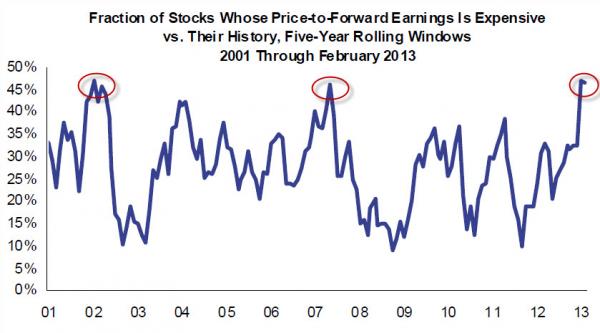
Now, it is very true
that relative return comparisons can drive market prices in the
short-run. For example,
investors may shift preferences toward stocks when they say that they
can get a 3% dividend from a stock of a good company versus getting less
than 2% from a 10-year government bond.
That is very different from saying that stock valuations are
attractive on an absolute basis, or on their own merit.
That same stock generating a 3% dividend can be priced at a very
high valuation on its own merits with investors paying up for that 3%
yield. This is just another
example of the distortions that come from irresponsible monetary
policies at the Fed. The
return comparison approach often ends in the realization after the fact
that both assets were over-valued.
Investors’ belief that
Bernanke will keep the stock market going is getting more and more
certain in their minds.
Just look at Jim Cramer the other evening pulling out a large garbage
barrel and filling it with fruit punch saying that a bowl is not large
enough to illustrate the party that Bernanke is providing, further
justifying that stock prices were only going to go higher.
That could end up being an interesting video marking a peak in
the delusionary faith in ‘ole Ben.
BUY MORE, AND THEN BORROW TO
BUY EVEN MORE…
Investors are
increasingly using borrowed money at Bernanke’s low rates to buy more
and more stocks. Let’s look
at a chart from Hussman of margin debt shown below.
This, to me, is very fascinating.
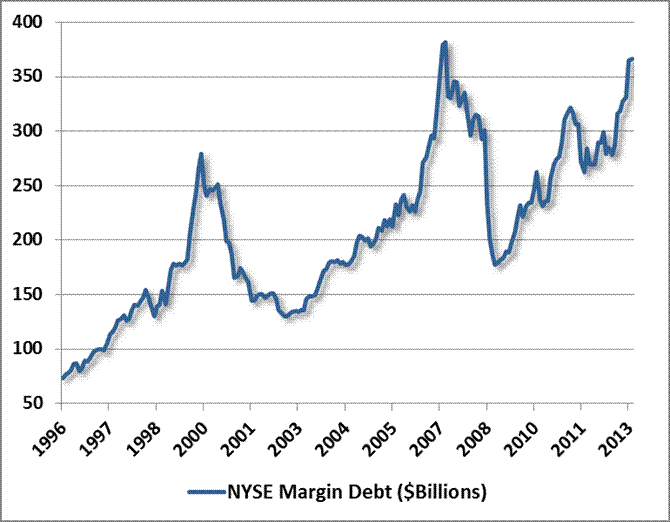
If you look at the
chart above, we saw a spike in margin debt with the euphoria associated
with the “new economy” of the internet and tech bubble leading to the
peak in valuations at the beginning of this secular bear market.
Then, just as the enthusiasm for high double digit returns in the
stock market as far as the eye could see peaked in 2000, the market
dropped 50% and margin levels also crashed down.
Greenspan acted by cramming interest rates down to 1% which
fueled a greater debt bubble.
This chart shows that investors were leveraging up their
portfolios similar to the way they were leveraging up their home buying.
Margin debt levels spiked even higher than the peak in 2000.
Then, the housing
bubble burst and stock prices collapsed more than the previous decline
in ’01 and ’02. As margin
calls came, margin debt imploded again.
Bernanke reacted by dropping rates to 0% this time and started
his printing press. Margin
debt levels are now almost back to the same extraordinary levels they
were in 2007.
This is really
incredible and shows that investors in mass have not really learned a
thing yet in this secular bear market.
They continue, like Pavlov’s dog, to follow the easy money
provided by the Fed to leverage up their bets.
After two drops of 50% or more in the last 13 years, I challenge
you to find anyone out there that thinks we could have another big drop
– a 10% correction is about the most anyone thinks is even in the realm
of possibilities.
I think one dynamic
that will identify the end of this secular bear market and a resumption
of a sustained move higher in prices is that after another big decline,
we see market prices bottom out again and start to move higher.
However, in that price advance, we do not see margin debt expand
much at all after this generation of investors finally begins to fear
the use of margin from being blown up by it a third time in this secular
bear market. If you are
going to use margin debt to buy stocks, that will be the time to do it;
when stocks are cheap on an absolute basis and there is a solid
foundation supporting a renewed sustained move higher in prices, instead
of speculating on a great fool game fueled by easy money.
Let’s take a look at a
few recent economic and market developments.
DON’T DISMISS AN UNNOTICED
RECESSION JUST YET…
Here is a chart of
Goldman Sachs’ Global Leading Indicator.
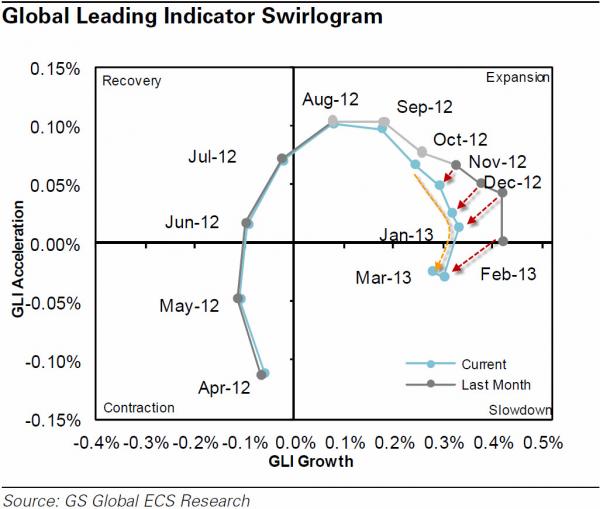
This may be a little
confusing but let me briefly explain.
You can see the four quadrants; Contraction in the lower left,
Recovery in the upper left, Expansion in the upper right, and Slowdown
in the lower right. If you
look toward the end of the swirl line, it breaks off into a gray line
and a blue line. The gray
line was the initial estimate while the blue line is the actual reading
and both show associated dates.
This shows that at the beginning of the year, expectations were
for the global economy to remain in the expansion phase.
However, reality has dramatically shifted the line into the
Slowdown phase. This is in
stark contrast to most of the economists out there predicting increasing
growth for the rest of the year.
I continue to think we
may actually be in an unnoticed recession here in the U.S. and that the
revised data and upcoming data will confirm it.
Just in the last week, we are starting to see the economic data
disappoint with weaker than expected readings in the national
manufacturing as well as services gauges and warnings from the likes of
Federal Express and Caterpillar.
Also, both the economic surprise indexes for the U.S. and Europe
have turned sharply down in the last week or two.
Many economists have
been predicting continued improvement in the jobs numbers.
The latest ADP numbers disappointed and we’ll see what we get on
Friday from the BLS on unemployment.
Here is an update of ECRI’s charts showing year-over-year
employment, which reduces some of the seasonality issues of recent
monthly comparisons.
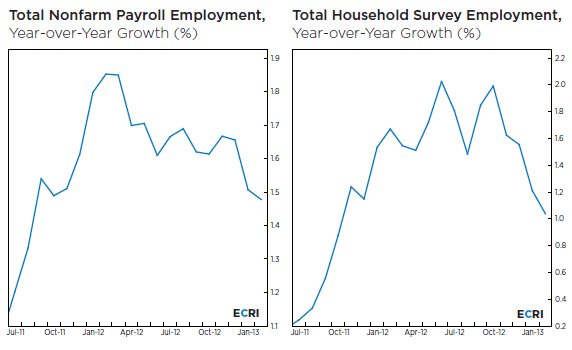
They look more like
recessionary trends to me and the update this Friday may extend both
lines lower.
MARKET INTERNALS ARE
WEAKENING…
Now, let’s take a look
at some additional emerging divergences.
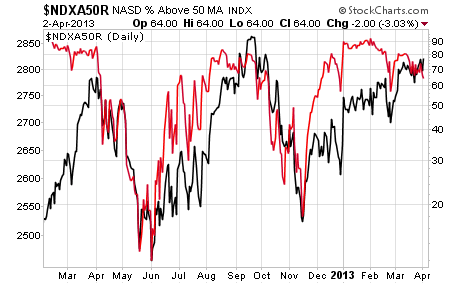
The chart above shows
the Nasdaq 100 index in the black line and the number of stocks in that
index trading above their 50-day moving averages with the red line.
What we see from the chart is that the red line often leads the
black line. Let me explain
what this is saying. This
was recently highlighted on Stockcharts.com.
When the red line is
rising, more and more stocks in the index are trading above their 50-day
moving average which is a short-term trend line.
When it is falling, an increasing number of stocks in the index
are dropping below the same short-term trend line.
Topping patterns in the
market often are characterized by the price of the major indices
continuing to rise but with fewer and fewer stocks participating in the
rise. Then, more and more
stocks start to break below their short-term trend lines [i.e., 50-day
moving average]. If you
look toward the end of the chart, you see that more of the Nasdaq 100
stocks are breaking below their 50-day moving averages and this is also
true of a number of the main indices.
Here are a few charts
of economically sensitive areas of the market.

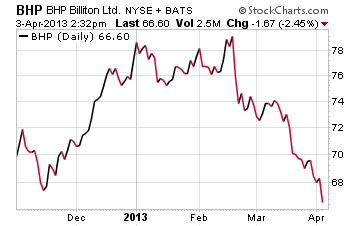
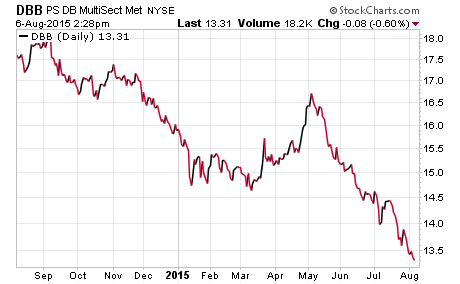
Base Metal Commodity Prices
Everyone knows
Caterpillar. BHP is the
largest mining company in the world, selling numerous kinds of
commodities used in the economy.
The last chart shows prices of various metals used in the
economy.
Let’s go ahead and wrap
up.
SAVERS UNITE…
In 1817, the poet
Samuel Coleridge created the concept of “suspension of disbelief.”
As described in Wikipedia, Coleridge said that if a writer could
infuse “human interest and semblance of truth” into a fantastic tale,
the reader would suspend judgment concerning the implausibility of the
narrative. The same concept
is used often in modern times for movies and magic shows.
Another definition of the phrase is; sacrifice of realism and
logic for the sake of enjoyment.
I think Bernanke is the
market’s chief poet and he has enticed most all investors into a willing
suspension of disbelief. He
and Greenspan did it with home buyers a few years ago and it is now more
directed specifically at the stock market.
He is artificially pushing up asset prices and printing over $1
trillion in new money a year while the government is spending $1
trillion a year more than it collects and all we are getting in the real
economy is 2% or less in growth.
Where is his wealth effect?
Prices continue to
disconnect from reality and valuations are getting more elevated.
Yet, investors are leveraging up their portfolios using margin
debt to buy more of what Bernanke is pushing.
Meanwhile, the economy continues to look to be weakening rather
than strengthening.
Upcoming first quarter earnings conference calls are likely to be
interesting.
More divergences are
appearing under the surface of the market and a number of the cyclical
areas are weakening while the most defensive areas like consumer staples
have been the sectors holding up.
Just yesterday, the Dow was up around 100 during the day while
the small caps and the materials sector were declining.
Today, the financials are joining in by leading to the downside.
Michael Steinhardt was
recently interviewed. He is
considered the father of the hedge fund industry and was probably the
best of our time. He said
that he has a lot of liquidity and is only invested in special unique
company situations. That is
probably the best way to be positioned at this time.
It is interesting that he said that he always had somewhat of a
bearish bent toward the market.
While he took advantage of plenty of opportunities over his
investing career, that bent helped to keep him out of trouble and avoid
the large losses that are hard to recover from.
As I close, I want to
highlight the best investment of the year so far.
I’ll give you a hint; it is up by 14X in the last three months.
The answer is; Bitcoin.
It is essentially a virtual currency.
It has recently emerged as an alternative currency to all the
fiat currencies being manipulated by global central banks.
The reason I am
highlighting this is that I think in the coming years we will see ideas
like this emerge more and more.
As the global central banks look to inflate their way out of
massive debt issues and bail out those that pursue profligate behavior
including the spending by governments, they are on a path to devalue the
currencies of their citizens.
It is interesting that if you look through history, when
governments overstep their bounds from their designed purpose the people
create ways to circumvent their policies.
The next major social
movement may just come from traditional “savers” not speculators.
They are the ones who have worked hard, saved their money, have a
dislike for debt and are taking the hit for Bernanke’s greater good
theory in economics. They
are represented most by the older generation and early baby boomers.
Their numbers are increasing from the aging population and they
are growing tired of Bernanke’s stealth Cyprus-like monetary policies.
The very conservative ones are fed up and once the stock market
reconnects to reality and away from Cramer’s Fed-induced fruit punch
barrel party, the rest will join and may not be so willing to suspend
their disbelief anymore.
Joseph R. Gregory, Jr.